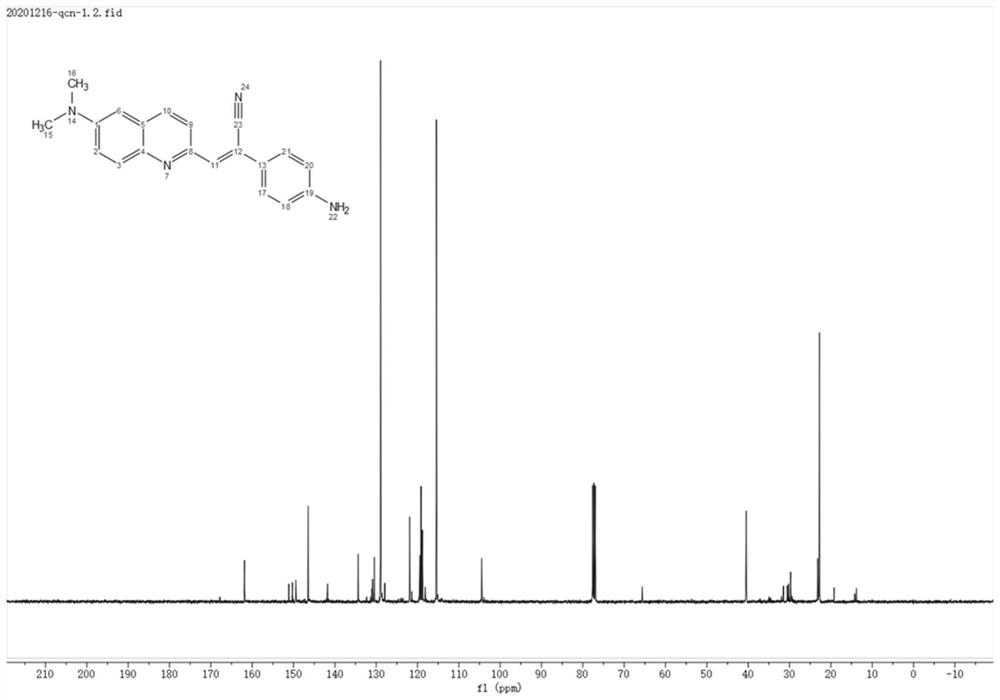Fluorescent probe with AIE property, preparation method and application of fluorescent probe in detection of transthyretin tetramer protein
A fluorescent probe and property technology, applied in the field of fluorescent probe detection, can solve the problems of tissue damage, large amount of collected information, and long cycle.
- Summary
- Abstract
- Description
- Claims
- Application Information
AI Technical Summary
Problems solved by technology
Method used
Image
Examples
Embodiment 1
[0055] (1) Synthetic steps of intermediate compound 1:
[0056] First prepare the hydrochloric acid solution (HCl:H 2 O=1:1, volume ratio) 250ml, stir evenly, add 5.8g (42.6mmol) of N,N-dimethyl-1,4-p-phenylenediamine, after stirring evenly, add 7ml of crotonaldehyde, mix well Then 30 ml of toluene was added to the reaction solution, and the mixture was refluxed for 7 hours under the protection of nitrogen at 115°C. Thin-layer chromatography confirmed that the reaction was complete, the reaction was stopped, and the reaction was allowed to stand at room temperature. First remove the upper layer of toluene solution, then adjust the pH to neutral with NaOH saturated solution under ice bath conditions, then add an equal volume of dichloromethane (DCM) to extract at least three times, and finally separate and purify by column chromatography (silica gel 100-200 mesh; Petroleum ether: ethyl acetate = 20:1, v / v), and 3.47 g of a yellow solid, namely intermediate compound 1, was obt...
Embodiment 2
[0072] (1) Fluorescence spectra of fluorescent probe QCN-1 in different proportions of water content
[0073] The AIE optical properties of the fluorescent probe QCN-1 were investigated using tetrahydrofuran as a good solvent and water as a poor solvent. In the tetrahydrofuran-water system (the amount of water in the system increases from 0 to 100% (volume percentage)), a fluorescence spectrometer is used to measure the fluorescence emission spectrum of the probe molecule and record its fluorescence intensity value. The fluorescent probe concentration was fixed at 10 μM, and the excitation wavelength was 409 nm.
[0074] The resulting fluorescence spectrum was Figure 4 Shown: It can be seen from the figure that the fluorescent probe molecule QCN-1 exhibits weak fluorescence emission in anhydrous tetrahydrofuran, and its fluorescence emission intensity increases continuously as the volume ratio of water in the tetrahydrofuran-water system increases. When the proportion of wa...
PUM
 Login to View More
Login to View More Abstract
Description
Claims
Application Information
 Login to View More
Login to View More - R&D
- Intellectual Property
- Life Sciences
- Materials
- Tech Scout
- Unparalleled Data Quality
- Higher Quality Content
- 60% Fewer Hallucinations
Browse by: Latest US Patents, China's latest patents, Technical Efficacy Thesaurus, Application Domain, Technology Topic, Popular Technical Reports.
© 2025 PatSnap. All rights reserved.Legal|Privacy policy|Modern Slavery Act Transparency Statement|Sitemap|About US| Contact US: help@patsnap.com



